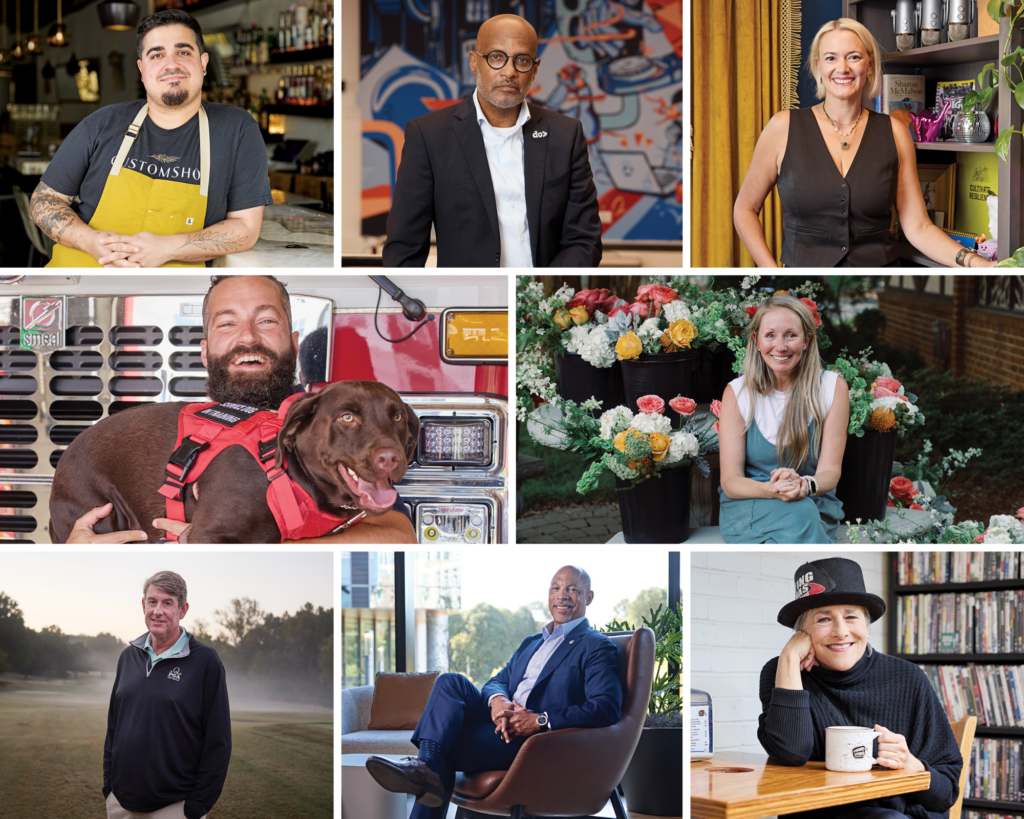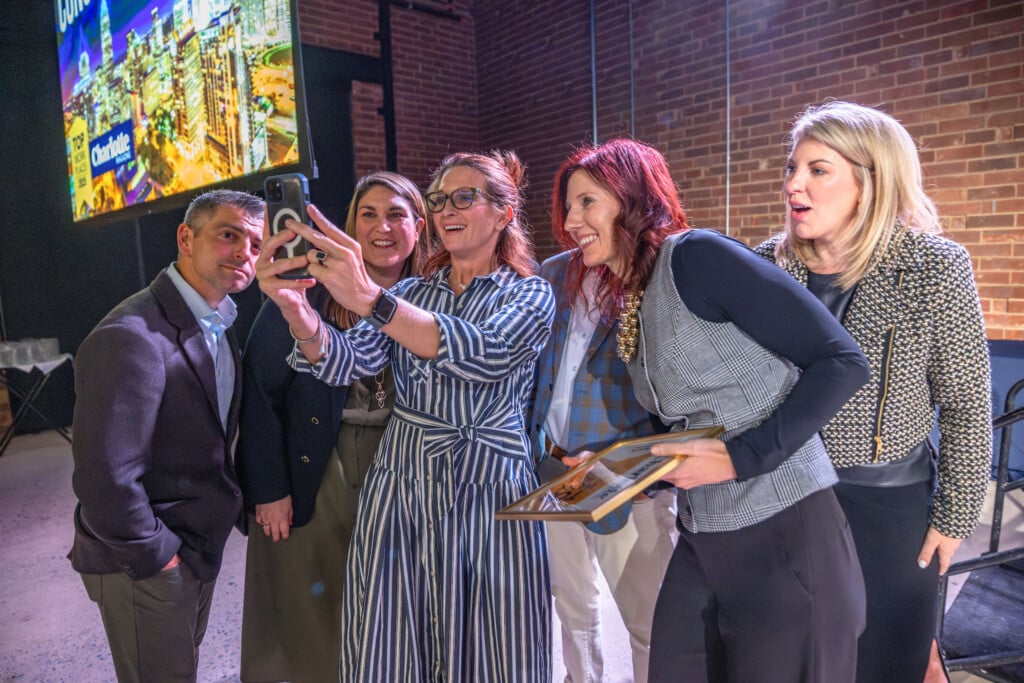AI In Charlotte: Where and How The Robots Are Taking Over
We’ve lived in a high-tech world for years, but new advancements in artificial intelligence have further eroded the line between humans and machines. Do we welcome our new AI overlords? Do we have a choice?

Look at the wonders artificial intelligence grants us: Well-organized, multisource essays through ChatGPT; a pocket reference assistant in Siri; technology that can create a face that looks just short of real.
But can you really tell what’s real and not when reality lives on a screen? The apprehensions many of us have held for years about high technology taking our jobs and remaking our world have absorbed fresh content and alerted us with a loud “ping.” The U.S. Government Accountability Office, on its web page about AI, refers to its “possibilities and perils,” which about sums it up.
Like it or not, it’s everywhere we look, and its escalation from merely predictive to generative—i.e., it can produce its own content—is the main reason why we’ve been talking about (and to) it so much in recent years. We exchange money with it, learn through it, even order biscuits at the drive-thru with its assistance. (Make that a large Cheerwine.) It will continue to frame and inform our lives. As with the technological advances of the past, we’ll have to learn how to manage it.
See where AI is popping up in Banks, Schools, Real Estate, Restaurants, and more.
Charlotte Banks: All In On AI
Charlotte’s banks have bet on AI-powered chatbots, but they haven’t joined the generative AI frenzy—yet
Facebook founder Mark Zuckerberg famously summarized the company’s ethos as “move fast and break things.” Banks have seldom adopted the same strategy, and those that have—the defunct Silicon Valley Bank comes to mind—have met the consequences. It is not an industry known for digital razzle-dazzle. The sector routinely lags behind its tech industry peers in innovation, and the global management consulting firm McKinsey & Co. found in 2023 that “(m)ore than half of digital banking transformations exceed their initial timeline and budget—or fail.”
But banks have little choice but to adapt. As cross-industry platforms like Amazon, Google, and Microsoft entrench their power, banks reckon with shrinking profit margins and uncertain futures. The stock market doubts the industry’s ability to future-proof itself; McKinsey reported in 2022 that the banking sector’s “price-to-book value has fallen to less than one-third the value of other industries.”
Enter artificial intelligence. Last year, the McKinsey Global Institute, McKinsey & Co.’s research arm, estimated that generative AI—the content-creating wonder tool of the moment, ChatGPT and the like—could add between $200 billion and $340 billion per year to the banking sector’s value. None of Charlotte’s big-name banks—Bank of America, Wells Fargo, and Truist—have introduced generative AI chatbots yet, but all have incorporated other AI technology into their customer service strategies. The shift is already paying off. The chatbots answer millions of customer questions—and promote the banks’ products. Will it be enough?
In 2018, Jorge Camargo left his job at The Walt Disney Co. to lead Bank of America’s mobile app team. Now, he’s a managing director and the head of digital platforms, which includes the mobile app; online banking; and Erica, the bank’s AI assistant, which launched in 2018. “You can see a connecting thread there,” he says. What he means is, there’s magic in Erica.
In their frenzy to adopt AI, companies routinely lose sight of what they want the technology to achieve. But in 2018, well before the generative AI trend, Bank of America developed Erica to meet a specific need: It would answer clients’ everyday questions and help them navigate the banks’ features and capabilities.
Erica is built on a type of AI called natural language understanding, which translates users’ questions into a language the machine can understand. Camargo calls it “controlled AI.” Erica doesn’t generate content the way a generative AI bot would. Instead, it directs users to content and tools that Bank of America’s human employees have developed.
So, where’s the magic in that?
“We realized,” Camargo says, “that the magic really comes from Erica being able to potentially anticipate a question or concern.”
The feature is called proactive insights, and Camargo gives some examples of how it works: “Maybe you have some extra deposits or money sitting idle in your account. Here’s some options for you. Or, hey, we’ve projected your balance out over the next week. Here’s where you land. Would you like to make a deposit or potentially invest some of the extra money you have in your account?”
Proactive insights now account for 60% of Erica’s impressive usage. Last April, Erica surpassed 2 billion client interactions and had assisted 42 million clients since its launch.
Bank of America was ahead of the curve. In autumn 2022, four years after Erica’s launch, Wells Fargo and Truist announced plans to develop similar assistants. Both tools, called Fargo and Truist Assist, use the same type of natural language understanding AI as Erica.
Then, just weeks after the announcements, ChatGPT touched off a revolution.
When OpenAI launched ChatGPT in November 2022, no one inside the San Francisco-based tech company expected it to reverberate the way it did. The company mainly wanted public feedback on a technology it had been developing for two years. Instead, ChatGPT became one of the fastest-growing internet services in history; two months after it launched, the generative AI chatbot had more than 100 million users.
Generative AI has since infiltrated our lives. More than 100 million people use generative AI tools every month, and 92% of Fortune 500 companies have adopted the technology. Some predict that, this year, as many as 95% of customer interactions will involve some type of AI.
Companies, banks among them, have scrambled to incorporate generative AI. Amsterdam-based global bank ING developed a gen AI chatbot in seven weeks. But moving fast means potentially breaking things. The team had to incorporate specific guardrails to meet security and regulatory requirements. It wouldn’t, for example, give advice on mortgages or investment products.
McKinsey’s 2023 report identified banking as one of the industry sectors that stands to benefit most from gen AI, primarily through improved productivity, and the consulting firm projected that the technology could help banks automate up to 70% of their business activities. Some banks use gen AI to draft templates for servicing documents, and wealth managers use it to synthesize and retrieve data from massive internal knowledge bases. Other banks are using it to help generate investment briefs and create hyper-personalized marketing messages.
Bank of America’s Camargo doesn’t discount the advantages gen AI could bring, but he’s cautious about implementing it in a customer-facing product. “A guiding principle here is, that has to be something that is additive to the client experience,” he says. “We would have to go through several iterations and feel very comfortable that generative AI technology is really ready for prime time.”
To describe its digital efforts, Bank of America has its own motto: “high tech, high touch.” It means that the bank aims for quality human interactions and quality digital interactions that support each other. (Truist has a similar slogan: “Technology plus touch equals trust.”)
Camargo envisions a future where AI tools can give bank clients a highly personalized and predictive experience. A tool like Erica might one day, among other capabilities, watch over client accounts and interact with the clients only to alert them to risks or suggest ways to optimize their finances.
But it remains to be seen whether that kind of tool will be enough to help the banking sector compete against companies like Google, whose gen AI chatbots may emerge as intermediaries between users and their financial service providers.
For now, Bank of America works to get clients to adopt the AI tools it already offers. Last year, it launched a campaign to market Erica as “the guide by your side.” When the bank’s customer service representatives wrap up their calls, they often encourage clients to go online.
“I know you’re going to have a lot of questions,” they say. “Ask Erica.” —Allison Braden
Schooled in AI
Generative AI is the new kid on campus, and its orientation is in full swing
Kiran Budhrani likes water metaphors. New technologies create waves of change in society and higher education, she says. And artificial intelligence has come into our lives like a waterfall: “It’s like a never-ending rush of water.”
Budhrani is the director of teaching and learning innovation at UNC Charlotte’s Center for Teaching and Learning, which provides professional development to faculty—to guide them as they guide students. Part of that work involves helping them use new technologies. Generative AI, which generates content, reached the public in November 2022 with ChatGPT. Its subsequent sweep over society has been quick and powerful—a swelling whitecap.
“AI is causing an institutional change, a cultural change,” Budhrani says. “It’s a way-we-work change, which means we’re undergoing an entire digital transformation.” It’s not unlike the changes the internet brought.
She and her colleagues have increasingly focused on AI over the past several years. Within months of ChatGPT’s release, the Center for Teaching and Learning rolled out its now-annual AI Institute for Smarter Learning conference, which convenes educators to explore generative AI tools for the classroom and planning. The center also regularly holds other AI-focused workshops throughout the year. As of late last year, Budhrani estimated that the center spent 50% of its time and resources on AI research and training, and she expected that percentage to increase in 2025.
UNCC professors in every professional school now use generative AI to improve their teaching, says Jordan Register, the center’s faculty development specialist. She gives examples: They’re creating lesson plans, study guides, graphics, and slide decks more efficiently and effectively. They’re using it to improve correspondence with students, such as making an email read more empathetically. They’re discovering new ways to explain concepts and generating math problems to discuss in class. (At this point, generative AI still makes a lot of mistakes. Some teachers are taking advantage of that, too. Sometimes, using it in class means having the class determine whether the generated answer is correct or incorrect, and why.) Nursing and business school faculty use it to create unlimited diverse case studies. And all the while, she says, students learn how to use the technology responsibly, to take it into the workforce and beyond.
But aren’t they concerned about students using generative AI to cheat?
“Students have cheated forever and will continue to cheat forever, whether they’re using AI or Wikipedia or a blog post or whatever,” Register says. “Sure, it makes it a little harder to detect. But part of our job, too, is implementing best practices in teaching and learning.” Most students cheat, she continues, because they don’t manage their time appropriately. “If we design our courses better, design our assessments better, if teachers are more involved because they have time freed up now because of AI, then they can know how students are progressing before they get to the point of cheating.” They learn, she says, to ask questions that aren’t easily Googleable—that are tied to context and personal experience.
Budhrani adds, “Cheating is always a symptom of a problem, and the problem is never the technology. And we’ve found that encouraging, not discouraging, the use of AI is actually more effective in directing how students use it.”
UNCC is far from the only Charlotte higher education institution studying and implementing generative AI. Central Piedmont Community College launched a new AI associate degree program last fall, and a group of professors at Davidson College formed the AI Innovation Project to study it. But because of how quickly and thoroughly UNCC’s center dove in, Budhrani says, colleges and universities across the state and country seek guidance from her center. “Our role,” she says, “is to relieve some of that pressure from the waterfall.” —Tess Allen
Prime Real Estate
Agents use generative AI to find and sell properties
You like a lot of things about the house your real estate agent is showing you. But it doesn’t have the home office you want, and the small backyard is barren. You could turn the sunroom into an office, your agent suggests, but you have a hard time envisioning it. Does the backyard have enough room, you wonder, for a patio, garden, and grassy space for my kids to run around?
Your agent quickly uses AI to generate a few images. One shows the home’s sunroom arranged as an office; others show ways you could lay out the backyard to make room for a patio, garden, and plenty of play space.
Generative AI helps real estate agents work more effectively and efficiently, says Tiffany Johannes, general manager and broker-in-charge at Charlotte-based Re/Max Executive Carolinas. That matters, as 117 people move to the Charlotte area each day. Based on market research, McKinsey Global Institute predicts that generative AI could create as much as $110 billion in value for the real estate industry.
At their annual conferences this fall, both the National Association of Realtors and NC Realtors held multiple sessions for agents on how to use generative AI. In addition to image generation, Johannes says, the industry uses AI to search for listings with particular qualities, like a home office or recently renovated kitchen; scan and summarize leases and other paperwork; manage tenant requests and lease negotiations; help with client communications; generate property descriptions and social media copy; create virtual home tours; generate floor plans and architectural plans; analyze market trends and property values; and help identify investment markets and opportunities.
But generative AI comes with ethical considerations as well, she says, like generative AI’s ability to impersonate agents’ voices and likenesses. “It could look like I’m speaking when I’m not,” she says, “and I think that’s scary in real estate, and it’s also scary across the board, in terms of protecting consumers and protecting agents.”
Johannes and her colleagues worry, too, about AI-generated property images that convincingly masquerade as the real thing. If your agent posts those generated photos of the landscaped backyard but doesn’t disclose that they’re AI, it’s misleading to clients, Johannes says: “We just have to make sure we have our eyes open.” —T.A.
AI On The Table
How restaurant operators are using AI to streamline service
Two years ago, an Asian restaurant called Yiding Hot Pot opened in The Centrum shopping center in Pineville. A pair of robots named Wall-E and Eve transport food from the kitchen to customers’ tables. It might seem like a campy reference to The Jetsons, but this shift to robotic servers is just one of the ways restaurants are cutting costs in a time of inflation.
A 2023 survey from the National Restaurant Association found that 62% of restaurant operators don’t have enough employees to meet customer demand. Robotic servers can cost tens of thousands of dollars, but they can be cheaper in the long run than employees. They use AI technology to learn the restaurant layout, and they’ll never call in sick or require breaks.
AI is showing up in other areas as well. The pandemic ushered in more concerns about hygiene, which led to a spike in QR-code menus. Predictive AI could one day allow operators to adjust their inventory to curb food waste.
Charlotte-based Bojangles has rolled out Bo-Linda, an AI voice bot that takes drive-thru orders. Chief Information Officer Richard Del Valle says Bo-Linda was developed at the tail end of COVID, when the company had concerns about labor. “But as we started testing it, we’d already got most of our labor force back,” he says, “so it was not the primary driver.”
Del Valle looks at Bo-Linda as a tool that helps employees—not a replacement for them. “There were legitimate concerns, but this hasn’t cost employees their jobs,” he says. “This is a win. We’re more accurate with Bo-Linda in terms of fulfillment. Taking the order, ringing it in, and cashing out is a lot for one person to do. Now we’ve removed the order part, and drive-thru employees’ stress levels are down considerably.”
Bo-Linda debuted at the Bojangles on South Tryon Street in southwest Charlotte in late 2023, and at press time, she was in about 140 of Bojangles’ more than 800 locations. Del Valle says they have about 100 more on the way in 2025.
He estimates Bo-Linda saves between four and five hours of employee labor a day, and she particularly comes in handy when a human employee calls in sick and for the 5 a.m. shifts that are harder to fill. “It’s not a blowtorch to the bottom line, but it’s bottom line-friendly,” he says. “We introduced Bo-Berry cookies recently, and she’s really good at upselling those. Bo-Linda’s my hero. I thank her, and my wife always laughs at me. But we refer to her as a person and consider her a member of the team.” —Taylor Bowler
More Ways the Queen City Is Tapping Into AI
The Charlotte Hornets introduced the NBA’s first-ever virtual team store in October 2023. Created in partnership with Los Angeles-based AI company MeetKai, virtual users can shop the fan store inside Spectrum Center. This isn’t typical e-commerce. Using smartphones, computers, tablets, or virtual reality headsets, shoppers log onto the website, hornets.mkms.io; create 3D Avatars; and “walk” around the store to view, try on, and purchase real Hornets merch. It’s like playing a video game or walking around with a more interactive Google Street View—except that when you make a purchase, the real thing shows up at your door.
Northlake Mall installed AI license plate readers after a series of shootings in 2023. The readers are connected to the Charlotte-Mecklenburg Police Department’s database to help deter and catch criminals.
An imaging AI platform shaves as much as 20 minutes off the time it takes Novant Health physicians to diagnose and treat strokes. In 2019, Novant became the first health care system in the state to use the platform, Viz.ai, to assess brain images from CT scans for signs of blockages or enlarged vessels. It sends an alert to the radiology team if it finds one. Novant also uses a similar AI technology, HeartFlow, to detect cardiac disease and blockages.
Duke Energy has lofty climate goals that include reaching net-zero methane emissions by 2030 and net-zero carbon emissions by 2050. It’s using AI-powered satellites to monitor and identify methane leaks in its natural gas pipelines. Duke also uses AI tools for forecasting, safety, customer experience, reliability, and efficiency. Early last year, it invested an undisclosed amount in a startup called AiDash, which uses satellite data to monitor energy infrastructure.
In September, Charlotte-based commercial technology giant Honeywell announced it’s working to develop an AI-enabled mobile assistant that will help workers in retail and distribution centers to determine information like inventory status and location.
Thieves frequently target home improvement stores, according to the North Carolina Retail Merchants Association, because they sell small but high-value items. In response to its own rise in thefts, Mooresville-based Lowe’s has tested autonomous security robots at some stores, including in Charlotte, since 2023. The robots use 360-degree cameras and facial recognition software to identify thieves and people who stores have banned. The robots are meant to assist, not replace, Lowe’s human security. —T.A.











